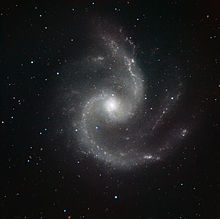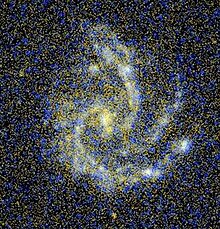| NGC 5247 | |
|---|---|
 Image of NGC 5247 made in infrared light with the HAWK-I camera on ESO's Very Large Telescope at Paranal Observatory. Image of NGC 5247 made in infrared light with the HAWK-I camera on ESO's Very Large Telescope at Paranal Observatory. | |
| Observation data (J2000 epoch) | |
| Constellation | Virgo |
| Right ascension | 13 38 03.040 |
| Declination | –17° 53′ 02.50″ |
| Redshift | 0.004520 |
| Heliocentric radial velocity | +1,357 km/s |
| Distance | 60.34 Mly (18.50 Mpc) |
| Apparent magnitude (V) | 10.5 |
| Characteristics | |
| Type | SA(s)bc |
| Apparent size (V) | 5′.6 × 4′.9 |
| Other designations | |
| UGCA 368, PGC 48171 | |
NGC 5247 is a face-on unbarred spiral galaxy located some 60 million light years away in the constellation Virgo. It is a member of the Virgo II Groups, a series of galaxies and galaxy clusters strung out from the southern edge of the Virgo Supercluster. This is a grand design spiral galaxy that displays no indications of distortion caused by interaction with other galaxies. It has two spiral arms that bifurcate after wrapping halfway around the nucleus. The disk is estimated to be 4.9 ± 2.0 kly (1.5 ± 0.6 kpc) in thickness and it is inclined by roughly 28° to the line of sight.
Supernovae
Two supernovae have been observed in NGC 5247:
- PSN J13375721-1754272 (type II-P, mag. 15.6) was discovered by the Catalina Real-time Transient Survey on 24 July 2012.
- SN 2016C (type IIP, mag. 15.7) was discovered by Masakatsu Aoki on 3 January 2016.

References
- ^ Skrutskie, Michael F.; Cutri, Roc M.; Stiening, Rae; Weinberg, Martin D.; Schneider, Stephen E.; Carpenter, John M.; Beichman, Charles A.; Capps, Richard W.; Chester, Thomas; Elias, Jonathan H.; Huchra, John P.; Liebert, James W.; Lonsdale, Carol J.; Monet, David G.; Price, Stephan; Seitzer, Patrick; Jarrett, Thomas H.; Kirkpatrick, J. Davy; Gizis, John E.; Howard, Elizabeth V.; Evans, Tracey E.; Fowler, John W.; Fullmer, Linda; Hurt, Robert L.; Light, Robert M.; Kopan, Eugene L.; Marsh, Kenneth A.; McCallon, Howard L.; Tam, Robert; Van Dyk, Schuyler D.; Wheelock, Sherry L. (1 February 2006). "The Two Micron All Sky Survey (2MASS)". The Astronomical Journal. 131 (2): 1163–1183. Bibcode:2006AJ....131.1163S. doi:10.1086/498708. ISSN 0004-6256. S2CID 18913331.
- ^ "NASA/IPAC Extragalactic Database". Results for NGC 5247. Retrieved 2007-04-03.
- ^ Crook, Aidan C.; et al. (February 2007), "Groups of Galaxies in the Two Micron All Sky Redshift Survey", The Astrophysical Journal, 655 (2): 790–813, arXiv:astro-ph/0610732, Bibcode:2007ApJ...655..790C, doi:10.1086/510201, S2CID 11672751.
- "The Virgo III Groups". Atlas of the Universe. Retrieved 2010-11-27.
- ^ Khoperskov, S. A.; et al. (December 2012), "Global gravitationally organized spiral waves and the structure of NGC 5247", The Astrophysical Journal, 427 (3): 1983–1993, arXiv:1209.2879, Bibcode:2012MNRAS.427.1983K, doi:10.1111/j.1365-2966.2012.22031.x, S2CID 119186508.
- Patsis, P. A.; et al. (July 1997), "Interarm features in gaseous models of spiral galaxies", Astronomy and Astrophysics, 323: 762–774, Bibcode:1997A&A...323..762P.
- Bishop, David. "Bright Supernovae - 2012 - Entry for PSNJ13375721-1754272". Rochester Astronomy. Retrieved 11 December 2024.
- "SN 2016C". Transient Name Server. IAU. Retrieved 11 December 2024.
External links
 Media related to NGC 5247 at Wikimedia Commons
Media related to NGC 5247 at Wikimedia Commons- NGC 5247 on WikiSky: DSS2, SDSS, GALEX, IRAS, Hydrogen α, X-Ray, Astrophoto, Sky Map, Articles and images
This spiral galaxy article is a stub. You can help Misplaced Pages by expanding it. |